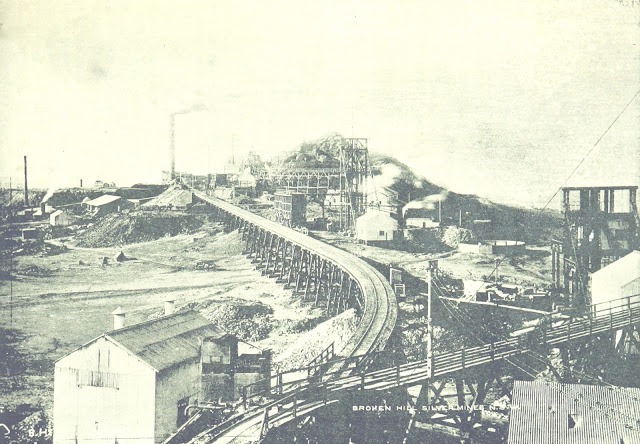Title: Broken Hill, Silver Mines
Silver
Silver
Excerpt from an article titled Mining Industry, by W. H. J. Slee, Esq., F.G.S., Chief Inspector of Mines, &c. - published in "New South Wales: the mother colony of the Australias" (1896)
Notwithstanding the low price of silver, there are still several mines in the Colony paying highly satisfactory dividends to the shareholders.
The most extensive and important (silver) argentiferous deposits are being mined upon in the Barrier or Broken Hill district, near the borders of South Australia. Here the ore deposits are very rich. They contain all the different species of silver ore, some of the chlorides or horn silver have been of very high quality, and it is generally admitted by mining experts that the deposits in the Proprietary Mine, Broken Hill, cannot be surpassed in quantity or quality by any of the present known argentiferous deposits in the world.
In addition to silver, the ore deposits also contain a fair percentage of gold, a large percentage of lead, also copper and zinc.
The following total yields, taken from the last report of the Proprietary Mine, Broken Hill, from 30th November, 1886 (the commencement of the Company's operations), up to the 28th November, 1895, being nine years, speak for themselves : —
Ore treated (gross) including moisture. — 2,512,742 tons 5 cwt.
Concentrates. — 53,748 tons 8 cwt.
Flue dust. — 26,664 tons 17 cwt.
Ore treated (net) including flue dust. — 2,400,388 tons 6 cwt.
Bullion obtained. — 289,336 tons 17 cwt.
Fine silver. — 74,276,099 oz.
Lead. — 287,061 tons 5 cwt.
The profit of the company for the half-year ending 31st May, 1895, amounted to £344,760 7s. 8d. This is certainly the principal company in the Colony in connection with the silver-mining industry. There are other large mines at Broken Hill, such as Block 10, the Central, the South Broken Hill, Block 14, British Blocks, the Junction, and North Junction, and others, which are all producing silver in payable quantities. About 5,000 miners are employed on these mines. Payable argentiferous deposits have also been discovered in different parts of New South Wales, some of which are now in actual work. Boorook, in the Tenterfield district; at Emmaville and Inverell, Glen Innes district; also in the Scone and Armidale district; at Sunny Corner, and other parts of the Bathurst district; Lewis Ponds and other parts in the Orange district; also near Binualong, Grenfell, and other places. In fact, the argentiferous area in the Colony is very extensive. The greatest question of the day in connection with our silver-mining industry is the successful treatment of our sulphide ores. If once this problem can be satisfactorily solved then a large increase in the production of silver may be looked forward to. Large and costly experiments have been made to solve this vexed question, and little by little one difficulty after another is overcome, and silver ores which only two or three years ago were considered as too refractory can now be treated with a profit. Strong companies are now starting with the sole object of buying and treating sulphide ores. The value of machinery in connection with the Barrier Silver-mines alone is estimated over £l,000,000, and this machinery is still being added to from time to time.
Provenance: "New South Wales: the mother colony of the Australias". Frank Hutchinson, Edited by F. Hutchinson.
Author: Frank Hutchinson
Date of Publication: 1896
Publisher: C. Potter
Place of Publishing: Sydney
Copyright status: This work is out of copyright
Courtesy: The British Library








No comments